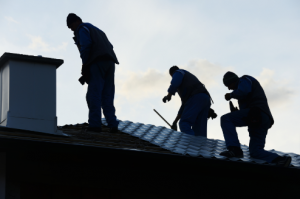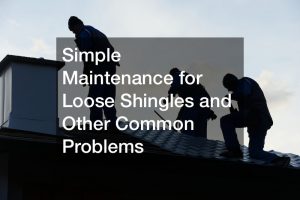10 Signs You Need a Roofing General Contractor
Deciding It’s Time For Roof Maintenance
Your roof does more than simply top your home—it protects your family, belongings, and the overall structure from the elements year-round. From blistering summer heat to torrential rain and heavy snow, your roofing system acts as the first line of defense. Yet, because it’s largely out of sight, it’s often out of mind—until something goes wrong. Unfortunately, many homeowners don’t recognize the early warning signs of roofing issues until damage has already taken hold. That’s why being proactive is essential, and having the guidance of a roofing general contractor can make all the difference.
A roofing general contractor doesn’t just handle repairs. They serve as a project manager, structural advisor, and trusted expert who oversee every stage of roof maintenance, repair, or replacement. These professionals coordinate teams, source quality materials, and make sure all work complies with local codes and safety standards. Their experience allows them to identify small issues before they grow into costly repairs, ensuring your roof functions efficiently and safely. Whether you’re dealing with storm damage, aging materials, or unseen leaks, a roofing general contractor brings the knowledge and tools needed to address the problem thoroughly.
Beyond solving immediate concerns, a roofing general contractor takes a holistic approach to your home’s exterior health. They know how roofing interacts with ventilation, insulation, gutters, and even energy efficiency. When these systems work together seamlessly, your home is more comfortable, your utility bills stay lower, and your property’s long-term value increases. This type of oversight is especially critical if your home is older or hasn’t been inspected in several years.

1. Noticing Water Stains on Your Ceilings
Water stains on ceilings are often one of the first visible signs that something is wrong with your roof. These brown or yellow discolorations may seem minor at first, but they usually point to a larger issue—namely, moisture making its way into your home through gaps or weaknesses in your roofing system. Left unchecked, water infiltration can damage insulation, promote mold growth, and compromise the structural integrity of your ceiling and walls. Acting quickly is key to preventing further issues.
A roofing general contractor can help determine the exact cause of the water intrusion and recommend targeted repairs. In many cases, the solution may involve bringing in a waterproofing contractor to reinforce vulnerable areas or add protective membranes. This collaborative approach ensures that not only is the current leak addressed, but future moisture issues are also prevented. By tackling both the visible symptoms and the hidden causes, a roofing general contractor helps preserve the safety and comfort of your home.
2. Seeing Shingles That Are Missing or Damaged
Missing or damaged shingles are a clear indication that your roof is no longer offering full protection against the elements. High winds, heavy rains, and sun exposure can cause shingles to crack, curl, or fly off entirely, exposing the underlayment and allowing water to seep through. Even a small area of missing shingles can create vulnerabilities that lead to leaks, insulation problems, and escalating energy costs. Regular visual inspections can help you spot these issues early.
When shingle damage becomes widespread or recurring, it’s time to call in a roofing general contractor. They can assess the overall health of your roof and determine whether you need repairs or a full replacement. The contractor may also work alongside roofing contractors who specialize in specific materials or techniques. By overseeing the project from start to finish, your roofing general contractor ensures the work is done efficiently, safely, and up to code—restoring the integrity of your roofing system and preventing further damage.

3. Discovering Mold or Mildew in the Attic
The presence of mold or mildew in your attic is often an overlooked warning sign of roofing trouble. These fungi thrive in damp, poorly ventilated environments and can develop when moisture enters through a compromised roof. Over time, this can impact indoor air quality and pose health risks to your household. Even if you don’t see active leaks, mold growth may indicate that water is seeping in slowly or intermittently—something that deserves immediate attention.
A roofing general contractor can thoroughly inspect the attic to trace the source of moisture and evaluate the condition of ventilation and insulation. In many cases, resolving the problem may involve roof inspections to identify hidden leaks or condensation buildup. The contractor can then recommend repairs or upgrades to restore proper airflow and ensure your roof is keeping your attic dry. With the oversight of a roofing general contractor, you get a full-picture solution that eliminates the root causes of mold—not just the symptoms.
4. Experiencing Frequent Roof Leaks After Rain
Recurring leaks after heavy rainfall are a strong indication that your roof’s protective barrier is failing. While one leak might be due to a localized issue, ongoing water intrusion across different areas points to systemic problems like deteriorating materials, poor sealing, or faulty design. These leaks not only create visible water damage but can weaken the overall structure of your home if left unaddressed.
A roofing general contractor is well-equipped to evaluate and resolve persistent leak issues. For homes with specialized roofing systems, such as flat roofing, the contractor can assess whether ponding water, improper slope, or material fatigue is to blame. By overseeing the repair process and collaborating with the right specialists, your roofing general contractor ensures long-term solutions are in place—preventing repeated disruptions and protecting your home from future rainfall.

5. Finding Granules in Your Gutters
If you’re seeing a collection of tiny, sand-like granules in your gutters or at the base of your downspouts, it’s often a sign that your shingles are breaking down. These granules are a critical layer of protection on asphalt shingles, shielding them from UV rays and weather exposure. Once they begin to wear away, your shingles become vulnerable to cracking, curling, and moisture damage—reducing their effectiveness and lifespan.
A roofing general contractor can assess the extent of this wear and determine whether spot repairs or a full shingle replacement is necessary. In many cases, this issue may call for coordinating with gutter services as well, especially if granule buildup is contributing to clogs or poor drainage. With a roofing general contractor managing the project, you get a comprehensive solution that addresses both roof surface deterioration and gutter performance—two components that must work together to protect your home effectively.
6. Spotting Sagging or Uneven Rooflines
A sagging or uneven roofline is a visual red flag that something more serious may be happening beneath the surface. Over time, the structural components supporting the roof—such as rafters or decking—can weaken due to moisture damage, poor construction, or age. Sagging often signals that your roof is under stress and may not be able to bear additional weight, especially during heavy rain or snow. This condition poses both safety and structural risks if not addressed promptly.
When you notice visible dips or slopes in your roof, a roofing general contractor should be your first call. They can perform a detailed inspection to assess the cause of the issue and determine whether a section of the roof needs to be repaired or rebuilt. In some cases, working with tile roof companies may be necessary to remove and reinstall heavy materials during the restoration. A roofing general contractor coordinates all these efforts, ensuring the job is handled with structural integrity and long-term reliability in mind.

7. Dealing with Rising Energy Bills
Unexpected increases in your energy bills—especially during extreme weather—can be tied directly to roofing inefficiencies. When insulation is compromised or ventilation is inadequate, your heating and cooling systems have to work harder to maintain a comfortable indoor temperature. Even small leaks or gaps in the roof can lead to significant energy loss, making your home less efficient and more expensive to run.
A roofing general contractor can evaluate the condition of your roof’s insulation and ventilation systems to identify any deficiencies. If your home has a metal roof, consulting with metal roofers may be part of the solution to enhance reflectivity and energy performance. With the right updates, managed by a roofing general contractor, you can improve your home’s overall efficiency and enjoy consistent indoor comfort without the shock of rising utility costs.
8. Hearing Unusual Sounds During Windstorms
If you hear banging, rattling, or flapping noises during high winds, it could be your roof trying to warn you of loose or failing materials. These noises often indicate that shingles, flashing, or underlayment are not securely fastened, which can lead to serious damage if left uncorrected. Strong gusts can tear off vulnerable sections entirely, exposing your home to rain, pests, and further wind-driven deterioration.
In this scenario, a roofing general contractor can provide a fast and accurate assessment, especially if you’ve experienced previous weather-related issues. They may recommend storm damage repair to replace compromised sections and reinforce your roof against future storms. With the right expertise and planning, a roofing general contractor ensures that your roof is properly sealed, secured, and ready to withstand the elements—quietly and confidently.
9. Observing Flashing That’s Loose or Rusted
Roof flashing—typically made of metal—is used to seal and protect the joints and transitions in your roof, such as around chimneys, skylights, and vents. When flashing becomes loose, cracked, or rusted, it can no longer direct water away from these vulnerable areas, leading to leaks and water infiltration. Damaged flashing is often difficult to spot from the ground, but it can be a major contributor to internal damage over time.
A roofing general contractor can closely inspect all flashing areas and identify weaknesses that may not be visible to an untrained eye. If the issue is centered around a chimney, they may coordinate with specialists who handle chimney repairs to ensure all components are properly sealed and reinforced. By managing the entire process, a roofing general contractor ensures the integrity of your roof system, eliminating the risk of moisture entering through weak flashing points.
10. Living in a Home with an Aging Roof
Even if your roof looks fine from the ground, age alone can be a strong indicator that it’s time for a professional evaluation. Most roofing systems have a lifespan ranging from 20 to 50 years, depending on the materials used. As roofs age, they become more susceptible to wear, weathering, and hidden damage. If your roof is nearing or past its expected service life, it’s wise to have it professionally assessed before problems arise.
A roofing general contractor can conduct a thorough inspection and help you understand whether it’s time for repairs, reinforcements, or a complete replacement. They may provide detailed roof estimates to outline the scope and cost of the work needed. With their expertise, you’ll gain a clear plan for maintaining or upgrading your roof before issues escalate. A roofing general contractor gives you the information—and the execution—you need to make smart decisions about your aging roof.
Scheduling Your Roofing Consultation
Your roof is your home’s first line of defense, and spotting issues early can save you from significant stress and expense. From minor leaks to major structural concerns, the signs that you need professional help aren’t always obvious at first, but they can quickly become severe. That’s why having a trusted roofing general contractor on your side is so important. These professionals not only diagnose visible problems but also uncover the hidden causes that DIY fixes or patch jobs may miss.
Whether it’s inspecting flashing, coordinating with specialty crews, or managing a full roof replacement, a roofing general contractor brings expertise and oversight to every aspect of the job. They ensure that each element of your roofing system—materials, structure, drainage, and design—functions together seamlessly to protect your home. If you’ve noticed any of the signs discussed in this blog, it may be time to take action. With the right roofing general contractor, you can resolve issues with confidence, restore your roof’s integrity, and preserve the value and safety of your home for years to come.









